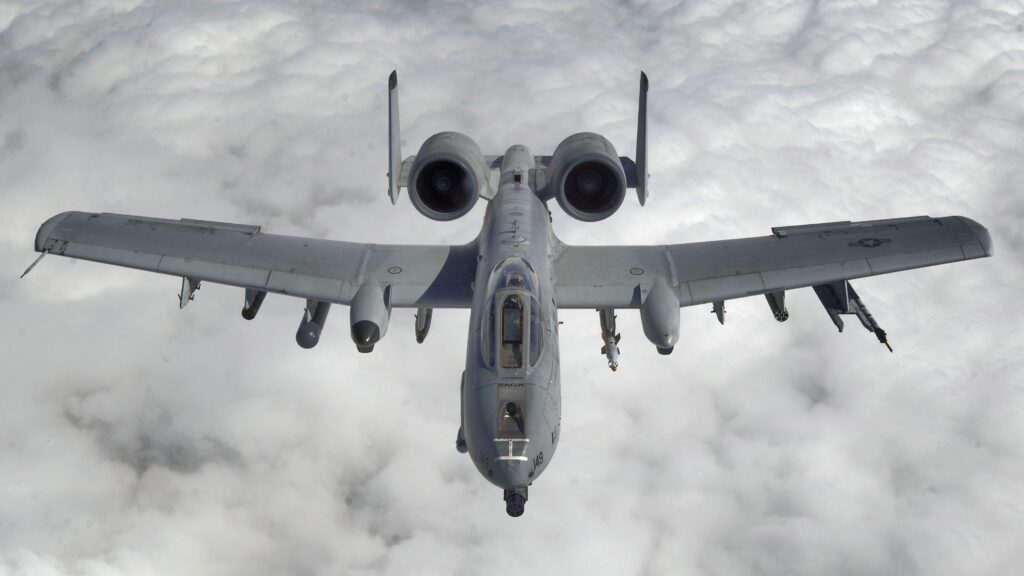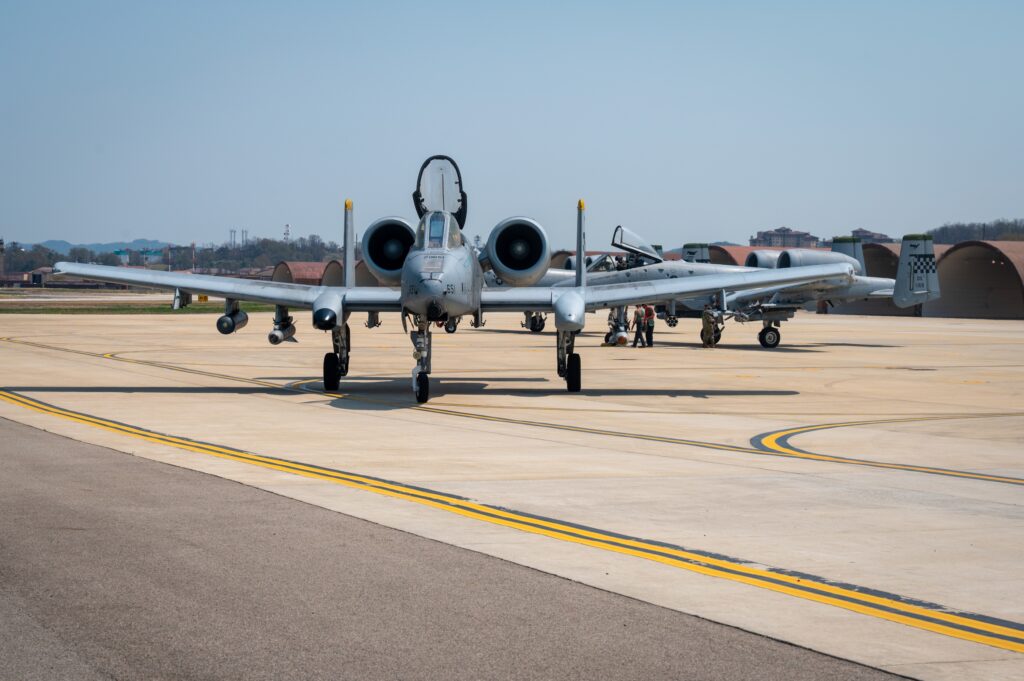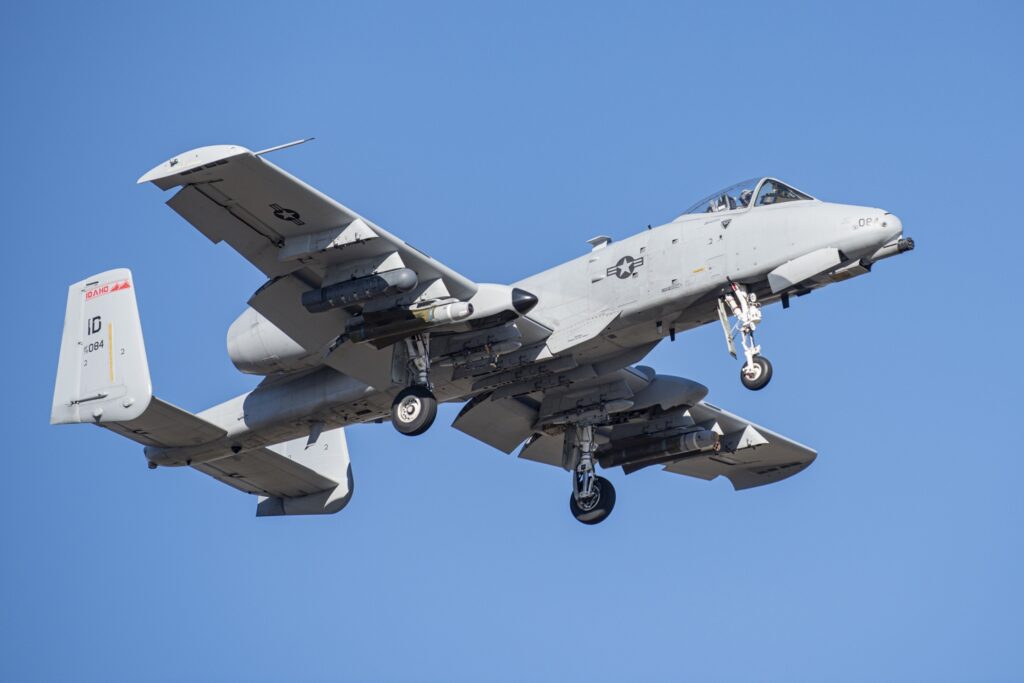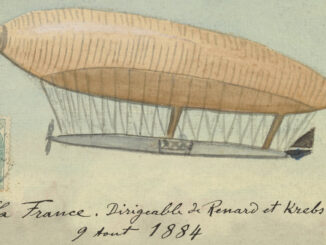 On 10th May 1972, a prototype of new American close air support (CAS) aircraft, designated YA-10, performed its maiden flight. Over the next fifty years the aeroplane, officially named A-10 Thunderbolt II but commonly nicknamed ´Warthog´ or just ´Hog´, became one of the most-known jet aircraft of the world and true Western icon of the Cold War years that was incorporated by mainstream culture.
On 10th May 1972, a prototype of new American close air support (CAS) aircraft, designated YA-10, performed its maiden flight. Over the next fifty years the aeroplane, officially named A-10 Thunderbolt II but commonly nicknamed ´Warthog´ or just ´Hog´, became one of the most-known jet aircraft of the world and true Western icon of the Cold War years that was incorporated by mainstream culture.
Beginnings of the most-recognized CAS aeroplane in the world should be sought in the Vietnam War. At that time, the USAF and US Navy were still operating Douglas A-1 Skyrider – a propeller-driven aeroplane developed at the end of the World War II. It had a good payload but the whole concept of a radial-engine powered and relatively slow aircraft was merely too obsolete for the 1960s. Approximately 260 Skyriders were lost in combat, most of them being shot down as a result of small arms fire.
Initial experiences from the Vietnam War made it clear that the US armed forces needed a new CAS aircraft, able to survive in a modern combat environment and featuring significantly increased firepower capability. Initially it seemed that two aircraft, being under development at that time, would be able to take over the role of ground attack aeroplanes. The first of them was General Dynamics F-111 Aardvark, an interdiction variant of the multirole combat aircraft emerged from the Tactical Fighter Experimental programme, and the second one was a fighter-bomber version of the already well-known McDonnel Douglas F-4 Phantom II.
Although both aircraft were well capable of their basic role of fighter-bomber, they did not match the requirements of the CAS missions. Both F-111 and F-4 were expensive jets, with high demands regarding maintenance, service and base airfields. In addition, their performance was at its best during high-speed and high-altitude missions that was quite opposite to CAS environment.
Another attempt to create the ground-attack aircraft was made by Ling-Temco-Vought consortium that developed a carrier-capable subsonic jet, A-7 Corsair II. Introduced in 1967, the A-7 quickly replaced the remaining Skyriders in their role of the CAS aeroplane. Adopted by the US Navy, the USAF and the Air National Guard, the Corsair II was operationally used during most of major conflicts of the 1970s – 1990s and was retired from the US armed forces in 1993.
Nevertheless, despite being considered a capable ground-attack aircraft, the Corsair II still was not exactly the aeroplane the USAF wanted for the CAS missions. The A-7 was considered too expensive regarding purchase price and then maintenance, as well as still vulnerable due its classic design and being powered by a single jet engine.
Eventually in 1966, the USAF decided that a new CAS aircraft must be developed, strictly tailored to the specialized needs of such operations. On 22nd December that year, Requirements Action Directive was issued, officially launching the new programme of Attack Experimental aircraft (A-X). In April of 1967, twenty one defence companies were officially requested to provide information related to the programme.
The next step was Concept Formulation Package, focused on four specialized areas – airframe and propulsion, avionics, armament and survivability. Each of the contractors was asked for submitting its recommendations and ideas for any of the abovementioned topics. Further discussion on the general concept of the aircraft lasted until 1970.

Although it may seem to be a very long time for creating the basic idea of the CAS aeroplane, we should not forget that it was the first time in the USAF history when such a narrow-specialized jet was being developed. All previous ground attack aircraft were done by conversion from already existing designs – but this time it was clear that such a concept was not enough and completely different approach was needed.
Cold War developments were among the major factors that influenced the shape of the new CAS aircraft. It seemed that the Soviet Union and the Warsaw Pact countries were getting more and more stronger, regarding both military and political power. In 1968, the Soviets and their allies invaded Czechoslovakia thus cutting the country´s attempt to create a better variant of socialists state. In 1970, the Soviet Air Force introduced into operational service MiG-23, a new fighter aircraft with fighter-bomber capability, and Su-17 fighter-bomber. The Soviet land forces then stationing in the Eastern Germany started to receive hundreds of T-64 main battle tanks, so feared by the Western military, and there were rumours that even more advanced tank was under development. Similar situation occurred when it came to armoured vehicles, as production of a revolutionary BMP-1 was at its full swing and prototypes of its successor were already tested.
No surprise that increasing Soviet capability in terms of offensive weapons impacted the future CAS jet for the USAF. Visons of hundred tanks and armoured vehicles advancing through Germany caused many sleepless nights among the Western military authorities. Therefore it was clear that the new ground attack aircraft had to be able to destroy both enemy armoured vehicles as well as their supply and logistic lines, at any weather conditions.
In May of 1970, the USAF issued a revised Request for Proposals (RFP), based on the years of study, discussions with contractors and military authorities, as well as a result of the latest Soviet developments in offensive armament. Following that RFP, the new aircraft had to have a payload of 16,000 pounds (approx. 7,300 kg), 460 kilometre mission range and maximum speed of 460 mph (approx. 740 kph). Keeping in mind the case of the A-7 Corsair II, simplicity in production and maintenance as well as the total cost of the single aircraft were also stressed in the requirements. Moreover, it was recommended that keeping cost at the low level had a priority over performance of the new CAS aeroplane. Nevertheless, one of the most important requirement that left its mark on design of the future jet was the need to include a 30 mm rotary cannon as its main on-board weapon.
It is customary to say that A-10 Thunderbolt II was built around the 30 mm Gatling-type rotary gun – and there is not much exaggeration in this statement. A programme focused on creating highly capable on-board cannon for the future CAS aircraft was launched parallelly with the A-X project. Final specification was issued in 1970 and offers were received from General Electric and Philco-Ford companies. Eventually, the GE proposal was chosen and all prototypes to be designed within the A-X programme had to incorporate the A/A 49E-6 Gun System (aka GAU-8) as the main weapon. Length and weight of the cannon, together with all necessary equipment, caused the airframe had to be specifically designed to carry that weapon.
Finally, in August of 1970, projects of the new CAS aircraft were submitted by six aviation companies but just two of them were chosen for further evaluation. In December of the same year the US military authorities announced that the projects made by Northrop (designated YA-9A) and Fairchild Republic (designated YA-10A) were the ones to receive contracts for manufacturing prototypes.

The prototype made by Fairchild Republic was the first one to fly. The maiden flight occurred on 10th May 1972 and the aircraft was flown by Howard Nelson. The YA-10 was a low-wing monoplane, powered by two General Electric TF34 jet engines that were located in separated nacelles high on the fuselage tail section. That, somehow non-traditional placing of the engines was chosen to maximize aircraft survivability – the nozzles are partially covered by tail stabilizers, reducing possibility of its exposition to MANPADS from the most common rear-bottom angle; in case the engine is hit, damages should be limited to the engine itself as the nacelle is separated from the fuselage; and, last but not least, it increases the possibility to operate from rough runways. Other important features were titanium-armoured cockpit, sturdy landing gear and double hydraulic flight system with additional mechanical backup.
The prototype of the second considered aircraft, the YA-9A, made its maiden flight on 30th May 1972. It was a shoulder-wing monoplane, powered by two Lycoming YF102 jet engines, put into nacelles placed under the wing roots. Characteristic shape of the Fairchild prototype was marked by a huge tail and its stabilizers that were to provide good directional stability at low-level missions. In case the YA-9 would be the winner of the A-X programme, its cockpit had to be armoured with titanium.
After a series of evaluation flights that were performed between October and December of 1972, the winner was announced on 18th January 1973. It was the aircraft proposed by Fairchild Republic that now officially was designated the A-10 Thunderbolt II.
Several rumours and hypothesis appeared on the reason why the YA-10 was chosen as the new US CAS jet. It was pointed that the YA-9 was in compliance with all the USAF requirements while the YA-10 exceeded the maximum landing distance and was a bit slower than initially requested. In addition, the Fairchild-made prototype was reportedly featuring better handling and capabilities. There were even some whispers saying the CAS contract was given to Fairchild in order to save the workplaces as the company had no other aircraft project to work on.
Nevertheless, the truth was that Fairchild Republic made a significantly better aircraft than the competitor. The abovementioned variations from the USAF requirements were acceptable, as – following the general recommendation – the performance could be sacrificed to save the cost and make the aircraft simpler. And the YA-10 was, as the USAF authorities stated, ´simple and responsible´ design. It was designed to be re-fuelled and re-armed within minimum time and using just basic equipment, low demanding on maintenance and therefore able to operate from forward air bases. Many elements from the left and right sections of the aircraft were interchangeable, including the engines. It also featured many small but important details, for example forward-retracting gear that can be released and locked by aerodynamic drag in case hydraulic power was lost.
Moreover, the YA-10 was powered by already known GE TF34 turbofan engines, used with Lockheed S-3 Viking, while YF102 power unit was a new, not yet proven design. And the final price of the YA-9 was expected to be a few million dollars more per aircraft than the cost of the YA-10. Malicious added that Northrop was great at building single prototypes but it was much worse when it came to serial production.
Nevertheless, the new CAS jet was chosen and it was the Fairchild Republic A-10 Thunderbolt II.
An interesting fact is that at the time both prototypes were evaluated their main on-board weapon was not ready. Therefore, both the YA-9 and the YA-10 initially flew with much smaller and lighter M61 Vulcan 20 mm rotary gun. The same was with the first production series of the A-10 – the aircraft were ready and taken over by the 355th Tactical Training Wing at Davis-Monthan AFB in March of 1976. But the GAU-8 was ready only in 1977.

Just to show how important it was to think about the GE rotary gun while developing the aircraft – the complete and combat ready GAU-8 makes more than 15% of a total weight of the unladen A-10 Thunderbolt II. Weight of the cannon is very important in maintaining the aircraft balance and centre of gravity and it also caused the front landing gear is moved to the right side of the A-10 fuselage. Particular care is necessary when removing the GAU-8 for inspections. The aircraft must always be secured by jacks to prevent it from tilt back on its tail.
The first A-10 of the serial production was ready in October 1975. Two years later, the 354th Tactical Fighter Wing was announced the first USAF unit to achieve combat ready status with their Thunderbolts II. According to their main purpose – destroying the Warsaw Pact tanks and armoured vehicles advancing West – the A-10s were assigned to forward operating units in Germany and the RAF stations in England. Nevertheless, some were also deployed to South Korea and Alaska.
The first years of service discovered a significant flaw in construction of the A-10 wings. It was initially discovered at the beginning of the serial production when most aircraft failed the 6,000-hour fatigue test. Some reinforcements were made and therefore lifespan was increased to 8,000 hours. Nevertheless, shortly thereafter another cracks were discovered, located close to the section where wings are mounted to the fuselage. Further tests that were launched in 1979, proved that another significant improvement is needed and about 240 aircraft underwent a retrofit procedure. The USAF had decided there is no need from the economical point of view to upgrade the early production aircraft.
Nevertheless, the issue was not removed and the problem with wing fatigue returned in 1995. They had to be solved by so-called HOG UP programme implemented by Grumman but finally, in order to extend the lifespan of the A-10s still remaining in operational service, the wing replacement programme was launched. The contract was awarded to Boeing in 2007, then halted in 2014 but re-launched again in 2015. Officially named the Thick-Skin Urgent Spares Kitting (TUSK), the project should allow the A-10s to remain in service until 2040.
The A-10 is one of the few aircraft being operated solely by the US armed forces – the USAF, the ANG and the Air Force Reserve Command. The aircraft remained in serial production until 1984 and more than seven hundred of ´Warthogs´ were made. With the end of the Cold War and budget cuts that followed, the number of the A-10s remaining in active service was progressively reduced and currently there is no more than 280 aircraft of that type in the US inventory. Nevertheless, not all of them were a subject of re-winging programme, therefore are now not able to fly combat missions.
Within a half-century of their service, the A-10s were the subject of several modifications. The first one was done already in 1978, when the ´Warthogs´ were upgraded to carry laser pod allowing them to use laser guided ammunition. Next, they were successively receiving some additional latest developments, such as GPS system, autopilot and advanced target aiming systems.
In 2005, the Precision Engagement programme was launched and the entire fleet of the A-10 was upgraded to new standard, designated A-10C. It included new fire control system, electronic countermeasures and advanced bomb targeting suite. Then a Helmet Mounted Integrated Targeting system was implemented, followed with all-weather combat capability, multifunction displays, Link-16 communication system and satellite communication suite. Nevertheless, the A-10s were a subject of constant upgrades to keep them up to date with the modern combat environment and other USAF aircraft. Those modifications were performed within the joint name of the A-10 Common Fleet Initiative.

In the late 1980s, some of the A-10s were modified to OA-10 standard – a forward air control aircraft. While still remain a fully combat capable ´Warthogs´, those aeroplanes were used for target marking as an airborne FAC point.
An interesting development was the YA-10B variant, designed as the night and adverse weather CAS aircraft. It was converted from one of the early ´Warthogs´ (s/n 73-1664) and featured a two-seat cockpit with the second seat intended for weapon systems operator. Nevertheless, there was no real interest in continuing works on that aircraft and it remained just a curiosity (now exhibited at Museum Air Park, Edwards AFB).
Although entered service in 1975, the ´Warthog´ had to wait sixteen years for its combat debut. It occurred during the Gulf War in 1991, with 132 aircraft of that type being deployed to the Middle East. Official reports acknowledge that four A-10s were shot down and eleven hit by anti-aircraft fire, resulting in writing off two more aeroplanes. On the other hand, the Thunderbolts II managed to shot down two Iraqi helicopters, both being hit with the GAU-8 cannon. In the Gulf War, the A-10s flew a total of 8,100 combat sorties.
Nevertheless, the A-10 was close to have its combat premiere already in 1983. That year, some ´Warthogs´ were deployed to support US Marines landing operations during Invasion of Grenada. However, the Marines met there no resistance at all, thus the air support for the landing forces was not necessary.
Another combat deployment of the A-10 Thunderbolt II was recorded between 1994 and 1995, with the NATO activities in Bosnia and Herzegovina (Operation Deliberate Force). Then another Balkan mission came, the Operation Allied Force in Kosovo, in 1999.
Starting March 2002, the ´Warthog´ squadrons were deployed to Pakistan to take part in operations over Afghanistan, within Operation Anaconda. Next, approximately sixty A-10s participated in Operation Iraqi Freedom – losing one aircraft from the Iraqi anti-aircraft fire.
Further combat developments included Operation Enduring Freedom in Afghanistan, Operation Odyssey Dawn in Libya and operations against the Islamic State – Inherent Resolve and Tidal Wave II.
While in combat, the A-10 proved its – almost legendary – survivability and also an exceptional effectiveness. The official USAF data disclosed after the Middle East and Afghanistan deployments reported the performance rate of 85 – 95 per cent. Nevertheless, operational use of the ´Warthogs´, as well as their future, all the time was marked by a question mark and accompanied by high political turmoil.
The post-Cold War years of the A-10 service were all the time marked by political debate on the need to keep the ´Warthog´ fleet operational, the number of active aircraft, as well as the future of the entire CAS specialized air force. Briefly speaking, money was the most important factor here. As a consequence, the history of operational service of the A-10 in the 21st century reminds a rollercoaster ride.
The first idea to entirely withdraw the A-10s from active service appeared shortly after the end of the Cold War. The ´Warthogs´ had to be replaced by modified variant of the F-16 Fighting Falcon but then the Gulf War started and the A-10 aircraft proved their usefulness there. Keeping that story short, in the times of political thaw, the voices requiring the ´Warthog´ retirements prevailed but then with outbreak of another conflict an opposite reflection came and the A-10 service was prolonged. And it was exactly that turmoil that stood behind halting and then re-launching the re-wing programme mentioned already above.

That discussion became even stronger in the late 2000s, with the introduction of Lockheed Martin F-35 Lightning II 5th generation aircraft. The USAF was then opting for retiring all single-mission aeroplanes and to replace them with new multi-mission capable platform based on the F-35. There were ardent supporters and opponents of such solution among the US military authorities and politics, nevertheless the A-10 remained in active service and the date of its withdrawal was successfully postponed – from the 2020s until the year 2040.
The Crimea and Donbas crisis of 2014, together with ongoing Russian invasion of Ukraine, put all those debates on hold, for the time being. With new tensions between the world superpowers and possible further developments of worldwide political situation, it seems that it is too early to retire the dedicated CAS aircraft.
Nevertheless, it seems that the future of the A-10 is still not certain. Although the war in Ukraine launched another upgrade programme for the ´Warthog´ fleet and their armament, the aeroplane designed and developed in the 1970s would have less and less chances to survive in a digital environment of the modern full-scale conflict.
The opponents of keeping the A-10 operational for an indefinite time are pointing the fact that in all previous conflicts the ´Warthogs´ were operating against significantly limited enemy, equipped mostly with obsolete anti-aircraft systems. However, combat missions performed during a full-scale conflict, against an enemy armed with modern anti-aircraft weapons and electronic countermeasures cannot be compared with sorties flown in Afghanistan, the Middle East or Libya.
And it seems they are, at least partially, right. With the development of the Russian invasion of Ukraine, the media were reporting long columns of the Russian armed vehicles, as well as supply trucks, stuck on the Ukrainian roads. It caused several demands on supplying Ukrainian armed forces with some ´Warthogs´ that – in the opinion of general public and some military – would destroy that columns quick and easily. Regrettably, such ideas were considered as mere wishful thinking by those who had real experiences with the A-10 combat operations. Not only due to time needed to train the ´Warthog´ pilot but also because of difficulty of operating the CAS aircraft against enemy equipped with variety of modern anti-aircraft weapons.
In addition, evolving use of precision armament and modern digital warfare environment more and more reduce foregoing advantages of single-task combat aeroplanes. Joint weapon platforms that are created nowadays allow their particular elements, such as aircraft, long-range artillery or UCAVs, to exchange data and complement each other. All of this shortly could mean an end of the ´Warthog´ story
It should be clear within the next few years if the specialized CAS aircraft is still necessary. At this moment, there are few ideas how to replace it completely by use the multi-mission aircraft – but another solution is to create a completely new, modern CAS platform. Nevertheless, implementing any of the abovementioned solutions will take years, if not decades, so the ´Warthogs´ should remain operational for another twenty years or so.

Cover photo: Cpt. Nick DiCapua pilots his OA/A-10 Thunderbolt II observation / attack aircraft to a precontact position behind a KC-135R/T air refueling aircraft, on 26 March, 2006 (USAF photo by Master Sgt. Lance Cheung).
All photos © U.S. Department of Defence (DoD). DoD information materials were used, in compliance with Public Domain licence. The appearance of U.S. Department of Defense visual information does not imply or constitute DoD endorsement.
Sources: DoD press releases, A-10 Warthog in Action by Lou Drendel (Squadron/Signal Publications, 1981), Fairchild A-10: Fighting Warthog by Rick Stephens (Aerospace Publishing, 1994)



